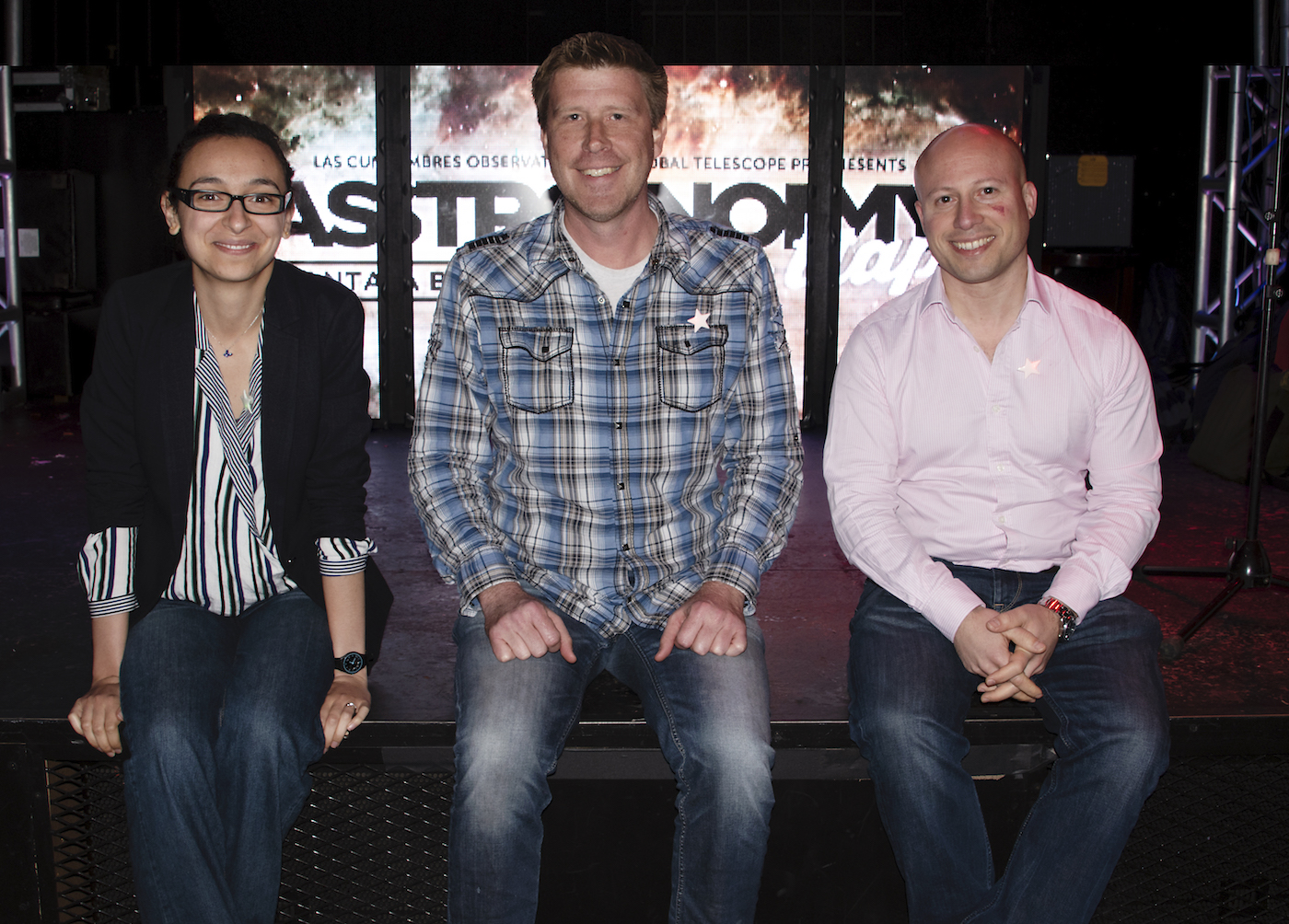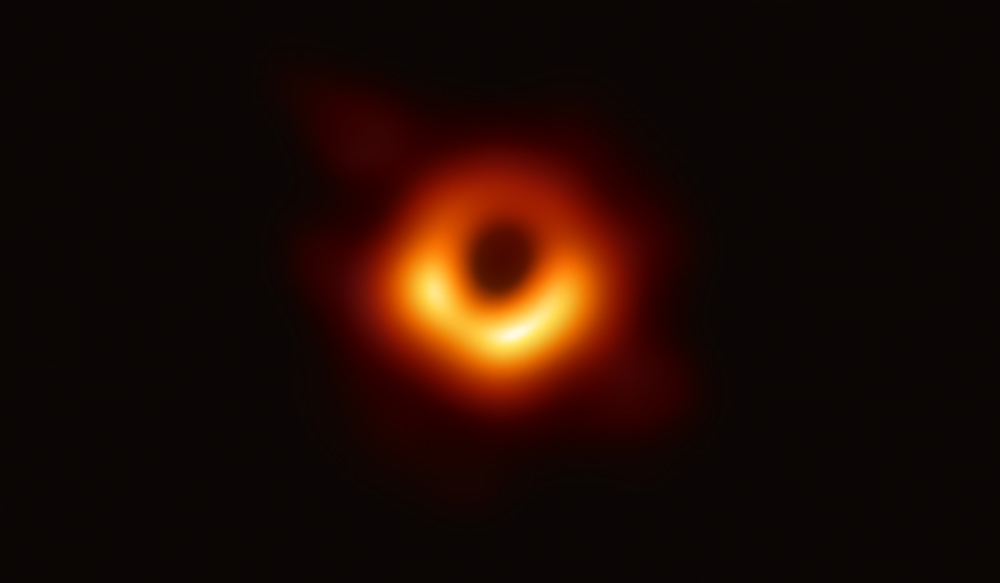Black Holes and Dark Matter News

On April 10, the Event Horizon Telescope (EHT) scientists historically released the first image of a black hole they have taken using observations of the center of the galaxy M87, a massive galaxy in the constellation of Virgo. This black hole is located 55 million light-years from Earth and has a mass 6.5-billion times larger than our sun.
The EHT uses a technique called very-long-baseline interferometry (VLBI) which synchronizes eight ground-based radio telescope facilities around the world and exploits the rotation of our planet to form one huge, Earth-size telescope observing at a wavelength of 1.3 mm. VLBI allows the EHT to achieve an angular resolution of 20 micro-arcseconds – enough to read a newspaper in New York from a sidewalk café in Paris. Petabytes of raw data from the telescopes are combined by supercomputers hosted by the Max Planck Institute for Radio Astronomy and MIT Haystack Observatory.
The telescopes used are: The ALMA and APEX telescopes located on the Chajnantor Plateau in the Chilean Atacama Desert; APEX is currently the largest radio telescope in the world and at an elevation of 5,100 meters. The IRAM 30-meter telescope on Pico Veleta in the Spanish Sierra Nevada at an elevation of 2850 meters; it is one of today’s largest and most sensitive radio telescopes for tracing millimeter waves. The James Clerk Maxwell Telescope and the Submillimeter Array Telescope located at the summit of Mauna Kea volcano, Hawaii at 4,207.3 m above sea level. The Sub-millimeter Telescopeisat the Mount Graham International Observatory Arizona. The Large Millimeter Telescope Alfonso Serrano, the world´s largest single-dish steerable millimeter-wavelength telescope for astronomical observations in the wavelength range of 0.85 – 4mm, is a binational project between Mexico and the United States of America and located on the summit of Volcán Sierra Negra Mexico at an altitude of 4600 meters. The South Pole Telescope located at the Amundsen-Scott South Pole Station, Antarctica 2.8 km above sea level.
Leading the group is Sheperd Doeleman at the Center for Astrophysics Harvard & Smithsonian, Event Horizon Telescope Black Hole Initiative Director and Assistant Director for Observation. His research focuses on studying super massive black holes with sufficient resolution to directly observe the event horizon. Confirming what they have is indeed a black hole, Paul T.P. Ho, EHT Board member and Director of the East Asian Observatory stated, “Once we were sure we had imaged the shadow, we could compare our observations to extensive computer models that include the physics of warped space, superheated matter, and strong magnetic fields. Many of the features of the observed image match our theoretical understanding surprisingly well. This makes us confident about the interpretation of our observations, including our estimation of the black hole’s mass.”
The Las Cumbres Observatory (LCO) April guest scientists, Dr. Lina Necib, a postdoctoral fellow at California Institute of Technology, and Justin I. Read, professor of astrophysics and head of the physics department at the University of Surrey, UK gave brief presentations on their Dark Matter research at the monthly Astronomy on Tap SB hosted by LCO Staff Scientist Andy Howell.

Lina presented dark matter direct detection, how this process depends on the velocity of the dark matter by tracking stars that have formed outside the Milky Way galaxy and were brought in with dark matter. She used simulations to show how these stars trace their dark matter counterparts, and how the Gaia Telescope measures these types of stars. She contends, “Our Galaxy is largely cannibalistic, feeding on smaller galaxies. A new structure, called the Gaia Enceladus, emerged from the Milky Way. Although we do not detect dark matter directly, measuring its speed is helping in tuning our experiments to its detection.”
Justin presented a general overview on dark matter, evidence for it, and why he thinks it is most likely a new particle. Using a wine glass and white paper with sketched black circles, he showed us how to simulate a gravitational lens that mimics the light-bending effects of dark matter. He said, “We now have evidence for ‘missing mass’ on all scales in the Universe, from the tiniest dwarf galaxies up to giant galaxy clusters. This mysterious “dark matter” appears to be almost completely invisible. It is most likely comprised of a weakly interacting massive particle that lies beyond the ‘Standard Model’ of particle physics. The race is now on to try to detect this particle in sensitive underground experiments, or to make some in high energy particle colliders like the Large Hadron Collider in CERN. While the idea of a near-invisible particle sounds crazy, in fact we already know of three such particles – the neutrinos.”
My interview with Lina and Justin:
Q: If you had to explain your work in Dark Matter to Einstein and Newton, what would you discuss?
Lina: If I had to explain my work to both of them, I would tell them that we used their theories of gravity to figure out there is a missing component of the matter in the universe that we call dark matter. My work focuses on determining the properties of dark matter by looking at stars that have accompanied dark matter when it merged into the Milky Way. My latest paper on the topic is called “Stellar Tracers of the Local Dark Matter Velocity Distribution in the Milky Way.”
Justin: I use the gravitational theories of Einstein and Newton to map out the distribution of mass inside galaxies. Comparing this map with the mass we see in stars and gas, we find that much of the mass needed to explain the gravitational field appears to be invisible. This “missing mass” is what we call dark matter. By comparing our maps of the distribution of dark matter with models, we can make inferences about what dark matter is. In my most recent work, we measured the amount of dark matter in the centers of the tiniest galaxies in the Universe: dwarf galaxies. We found, remarkably, that dwarfs that had more star formation had less dark matter in their centers. We interpreted this as evidence that the process of star formation pushes dark matter out from the centers of dwarfs, as was predicted by a host of recent models. The mechanism that “pushes” the dark matter out is purely gravitational. I like to think that both Einstein and Newton would have found the effect, that we now call “dark matter heating,” quite elegant.
What is it about dark matter that “matters” to you and why?
Justin: Dark matter is an enduring mystery. It makes up most of the mass of the Universe, yet we still do not know what it is. We have mounting evidence – including the work I discussed above – that dark matter comprises some new particle that lies beyond the Standard Model of particle physics. The idea that dark matter is made up of a tiny near-invisible particle might sound crazy, but we already know of such particles in the Standard Model: neutrinos. Neutrinos are nearly invisible (you would need ~a light year’s worth of lead to have a 50/50 chance of stopping one), yet we know they exist. They have mass and therefore produce a gravitational field. But they cannot be *the* dark matter because they are too light. Moving at almost the speed of light, neutrinos could not remain bound to our Galaxy and could not, therefore, explain its missing mass. But something like a neutrino that is heavier would be perfect. These “weakly interacting massive particles” are what scientists worldwide are searching for. If we can find this particle, it will be transformative. It will help us understand how the Universe as a whole formed, and it will show us which direction particle physics needs to go next. Ultimately, it may help us unify our understanding of the forces of nature, bringing us closer to a “theory of everything.”
Lina: I think it is an important question that is yet to be resolved. The fact that 84% of the matter in the universe is dark and we know nothing about it is challenging but exciting at the same time, and I am just dying to know what it is.
Yes or no: Many experiments to directly detect and study dark matter particles are being actively undertaken, but none has yet succeeded.
Lina: So far that is true, but we have to keep trying and open up the search parameter space by looking at direct detection experiments that target lower mass dark matter.
Justin: Yes I agree with this. There are a plethora of experiments worldwide. Some have found hints for a dark matter particle, but there is – as of yet – no fully convincing “smoking gun” detection. We must keep looking!
Get your science on July 2019: LCO presents a talk with professor Adam Riess, who along with Perlmutter and Schmidt, was awarded the 2011 Nobel Prize in Physics for his contributions to the discovery of the acceleration of the expansion of the universe.





